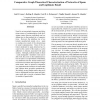Free Online Productivity Tools
i2Speak
i2Symbol
i2OCR
iTex2Img
iWeb2Print
iWeb2Shot
i2Type
iPdf2Split
iPdf2Merge
i2Bopomofo
i2Arabic
i2Style
i2Image
i2PDF
iLatex2Rtf
Sci2ools
CEAS
2005
Springer
2005
Springer
Comparative Graph Theoretical Characterization of Networks of Spam
Email is an increasingly important and ubiquitous means of communication, both facilitating contact between individuals and enabling rises in the productivity of organizations. However, the relentless rise of automatic unauthorized emails, a.k.a. spam is eroding away much of the attractiveness of email communication. Most of the attention dedicated to spam detection has focused on the content of the emails or on the addresses or domains associated with spam senders. Although, methods based on these - easily changeable - identifiers work reasonably well, they miss on the fundamental nature of spam as an opportunistic relationship, very different from the normal mutual relations between senders and recipients of legitimate email. Here we present a comprehensive graph theoretical analysis of email traffic that captures these properties quantitatively. We identify several simple metrics that serve both to distinguish between spam and legitimate email and to provide a statistical basis f...
| Added | 26 Jun 2010 |
| Updated | 26 Jun 2010 |
| Type | Conference |
| Year | 2005 |
| Where | CEAS |
| Authors | Luíz Henrique Gomes, Rodrigo B. Almeida, Luís M. A. Bettencourt, Virgílio A. F. Almeida, Jussara M. Almeida |
Comments (0)

